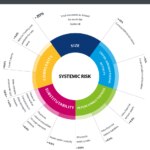Systemic risk: balance sheet size and other key issues
The fall of Lehman Brothers made it clear that the size of a bank can be important. Its collapse demonstrated the impact that an institution’s bankruptcy could have on the whole financial system and its repercussions for a country’s entire real economy. As a result, the G20 authorities sought to protect financial stability. Their first step was to identify other systemic banks.

Not long afterwards, several banks were rescued with government funds (‘bail-out’), but authorities realized that they needed to avoid using taxpayers’ money on failing banks in the future. This led to the regulation for banks to be the ones to absorb part of the losses (‘bail-in’).
The next step was determining that size is not the only thing that matters on a bank’s balance sheet, as there are other characteristics that define a systemic bank. The Financial Stability Board (FSB) has established the methodology and published a list of global systemically important banks (G-SIBs) since 2011. The list is generally published in early November, prior to the G20 meeting. The most recent list, published today, includes 30 institutions, 13 of which are located in the European Union.
Their methodology takes into account the size of the bank, as well as four other variables, broken down into 12 indicators. However, size is the indicator with the greatest weight in the FSB test.

There are two ways for a bank to be considered systemic. The first is this quantitative test; if the bank has more than 130 basis points it is considered systemic. The score is the sum of the result of each of the five variables: size, complexity, interconnectedness, the availability of substitutes for the services they provide, and their transnational business.
A bank that does not exceed the minimum score can also be included in the list based on expert judgment by the supervisor, even if it does not surpass the minimum score. In other words, in can be included based on a qualitative criterion. This was the case of BBVA in 2012 – 2014, when it was included in the list of G-SIBs. In 2015, BBVA exited the list, which will have practical implications starting January 2017.
The main consequences of being considered a global systemically important bank are on the one hand, being subject to the G-SIBs capital buffer requirement and to the future regulation of Total Loss Absorbing Capacity (TLAC), which will enter into force on January 1, 2019. Higher capital requirements intend to bolster banks’ resilience and the TLAC proposes that the institution’s creditors take on possible losses.
Furthermore, “among other things, the G-SIBs are subject to extra surveillance by supervisors and FSB assessment of their resolution potential; they are required to have a specific crisis management group; and present resolution recovery plans, or specific guidelines on how to address possible problems that could occur in an orderly manner,” notes Arturo Fraile, BBVA Research Economist in Regulation and Public Policies.
In a document published in April, the European Parliament explained that “because of the systemic threat they pose to the financial system, G-SIBs should be submitted to a specific set of rules and enhanced supervision.” It reached the conclusion that “being classified as a G-SIB and subject to enhanced supervision hence comes at a cost. Those consequences may in [the] future spark restructuring and downsizing processes so as to avoid the designation.”
So, to what extent can a bank’s size help or hinder its viability? For CUNEF School of Finance and Management Professor, Antonio San Frutos, it depends on the bank. “A bank’s size is related to its systemic risk in terms of solvency ratios. Basel III requires additional capital buffers for banks that are too big to fail, depending on the systemic risk assigned to each institution. In these cases, being big can adversely affect banks in comparison to their competitors, especially in a market like the financial services market that is so competitive and has such low margins.”
However, “integrating banks that are considered small or medium-sized can be advisable provided that the increase in size is justified by obtaining economies of scale and synergies. Making bigger banks alone will not improve profitability or solvency. And we have some recent examples in Spain that demonstrate this, like the integration of the savings banks,” indicates San Frutos.